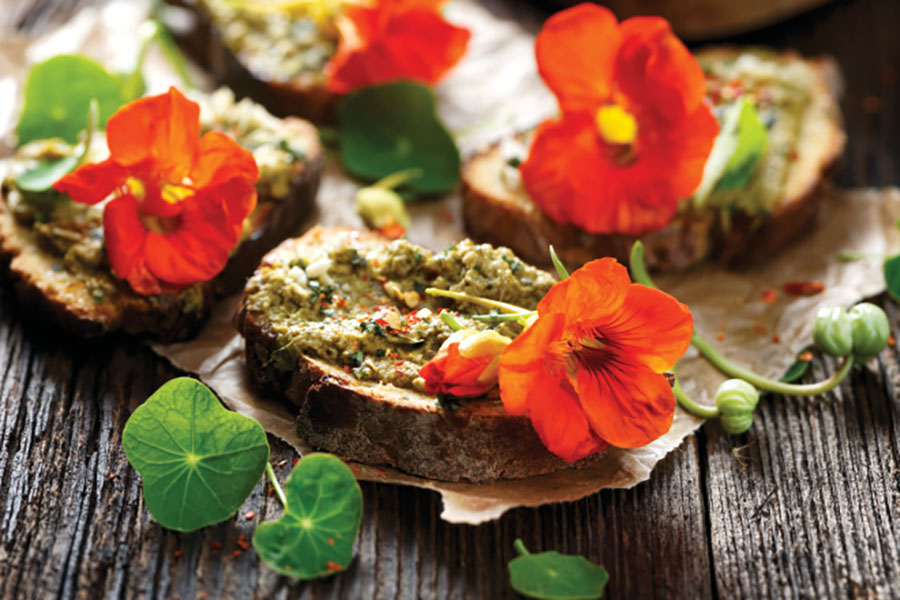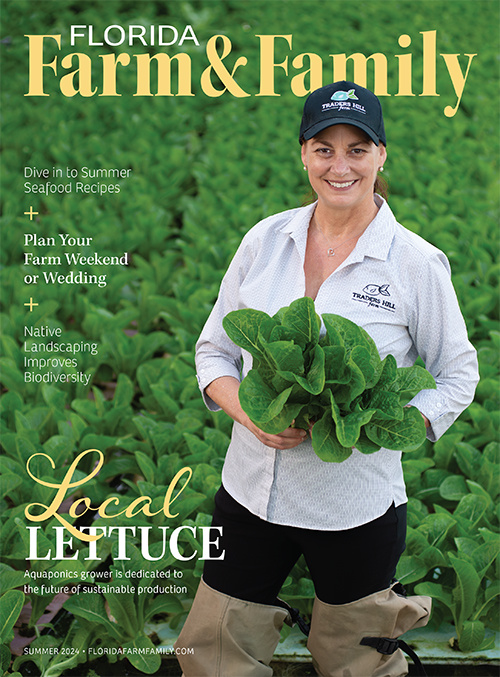
The time for family meals and festive entertaining is upon us. If you are a vegetable gardener, your fall crop is getting close to its prime, and if you aren’t gardening, there is plenty of local, fresh-from-Florida produce to put on the table. But what if you elevated those dishes beyond fresh by using edible flowers? Many folks don’t know that several flowers in our gardens and landscapes can be incorporated into our favorite culinary creations.
As you plan your special meals for the holidays, think about what dishes you could enhance with flowers harvested fresh from your garden. You must make sure the flowers are not sprayed or treated with any pesticides. If you are not sure your plants are untreated, purchase organic flowers from a local outlet.
From Bolting Blooms to Tasty Treats
Some of the easiest flowers to incorporate into your meals are the blooms of herbs. The flowers of rosemary are about an inch long and blueish-purple. They are an excellent edible garnish for roasted meats, soups and salads. Basil flowers have an herbal scent, blend well into salads and can be mixed into fresh basil pesto. The beautiful purple blooms of herb chives are gorgeous on soups and as a garnish on potato dishes.
When green leafy vegetables bolt (send up a flower spike), we usually recommend that you cut off the spike, but you can actually harvest their blooms. Flowers from collards, kale and mustard greens are small, bright yellow and make a tasty garnish in soups and salads. Arugula flowers are peppery and have a punchy zing similar to the leaves themselves. Even the flowers of sweet onions are edible and add a unique flavor to salads and casseroles. If you plant English peas in the garden, remember their blooms are edible and very tasty.
See more: 5 Easy Vegetables to Grow in Your Florida Garden
Winter Garden Favorites Add to Holiday Dishes
You may know that the big squash blossoms from zucchini and yellow squash can be stuffed with a savory filling and fried to create a delicious and stunning side dish, but did you know you can batter and fry daylily buds? The buds of daylilies harvested just before they are about to open are delicious and have a flavor similar to asparagus.
Some of the flowers we grow in our landscape and containers this time of year are edible, too. Pansies and violas are popular cool-weather bedding plants, and those sweet flower faces are delicious in salads. The flavor is reminiscent of fresh green peppers, and they look beautiful in salads and on cakes and other desserts. Crystallizing pansy or viola blooms in a simple syrup is very easy, and your guests will think you are a top pastry chef. These bright flowers add a special touch to lemonades and cocktails.
Nasturtiums are one of the easier edible flowers to grow. Their seeds start readily, and the delicious peppery flowers are red, yellow or orange. The bright-colored nasturtium flowers look stunning in a salad and are very high in vitamin C. Calendula is at home in the herb garden and the flower bed. The orange flower petals of this useful plant are great in salads and even better incorporated into an herbed butter. Calendula petals can also be used as a saffron substitute.
Marigolds are a workhorse in the flower garden, and they also perform in the kitchen. They blend well in salads and make beautiful edible garnishes that have a citrus flavor. Rose petals can be added to a salad or dessert and made into a rose syrup for cooking. Some chefs prepare a flower petal mixture with roses, marigolds and nasturtiums to make a fun flower petal confetti to decorate cheese or dessert trays.
Again, be very careful about using unsprayed and untreated flowers. For roses, do not rely on store-bought bouquets.
Look to your flower, herb and vegetable garden to inspire creativity in your holiday spreads. Edible flowers will make your festive moments more memorable and most certainly more delicious.
For more information on edible flowers, visit the UF/IFAS gardening solutions website, gardeningsolutions.ifas.ufl.edu/plants/ornamentals/edible-flowers, or contact your local county Extension office.
About the Author: Wendy Wilber is the statewide Master Gardener Volunteer Program coordinator and an environmental horticulture agent for UF/IFAS Extension.
See more: 4 Benefits of Home Gardening








